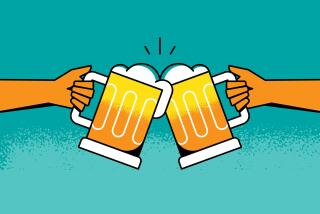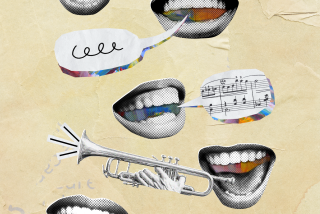A new Spanish manual could break the language barrier between being a barback or a bartender

- Share via
Fredy Garcia has been a bartender at the Harvard & Stone bar in Thai Town for the last year and a half. If you catch him behind the bar, his 5-foot 3-inch frame will probably be topped with a backward baseball cap or a beanie. He will definitely be wearing a silver chain around his neck.
Garcia has worked at the wartime factory-themed bar, owned by Los Angeles bar veterans Mark and Jonnie Houston, who also own the bar La Descarga, as a cleaner, then a busboy and a barback over a seven-year period. So why did it take Garcia six years to move up to the position of bartender? English is not his first language.
He moved to Los Angeles from Oaxaca, Mexico, in 2005, when he was 19 years old. In search of work, and what he calls “a good family life,” Garcia ended up in the Los Angeles service industry, working as a dishwasher at an IHOP and at the Abbey in West Hollywood.
“When you first come here, you do whatever is available,” says Garcia. “Dishwasher, cleaning, prep. I started as a dishwasher but I didn’t want to be doing that for long.”
Garcia is one of the more than 10 million foreign-born workers in California, whose first language might not be, and likely isn’t, English.
“It’s difficult because my first language is Spanish,” says Garcia. “Sometimes I use Google Translate, or I ask the other bartenders what this is called, how to do this, what’s the difference between this and this. Making the drinks is not difficult. Talking to the customers when we first open is sometimes hard because of my English.”
Harvard & Stone bar manager Aaron Polsky, who has worked at the bar for a little more than two years, saw Garcia’s trajectory as representative of a greater issue facing the Los Angeles bar industry: Spanish-speaking cleaners and barbacks never receive training to become bartenders.
“It’s been this sort of unsolvable, irreconcilable problem for a long time,” says Polsky, who has five to six barbacks who he believes should be able to train to become bartenders. “It’s not that the person [Garcia] is not competent, he never got the training.”

So Polsky, who has worked at Milk & Honey and Eleven Madison Park in New York City, decided to train Garcia to become a bartender. The only problem? Polsky doesn’t speak Spanish, and he couldn’t find a bartending manual in Spanish to share with Garcia. After attempting to translate his own bar training manual into Spanish, Polsky reached out to his friend Kevin Denton, who works with Pernod Ricard, the spirits distribution and marketing company behind the 10-year-old BarSmarts online bar training program. According to Denton, the 10-hour BarSmarts online program, which costs $29 to complete, has been completed by more than 22,000 individuals. And the BarSmarts staff certified tool has been used by more than 4,000 bars nationwide.
“When you talk about leveling the playing field for people, it should be done in a sense of providing everybody educational opportunities to better themselves,” says Polsky. “And this is the most thorough, useful way of doing this for our industry.”
Denton says Pernod Ricard was already working on getting the manual out in Spanish when Polsky approached him with the idea.
“We had actually already started this initiative internationally and because of the popularity of the program, we had been looking into doing the translation,” says Denton. “We that work in the food and beverage industry have worked alongside [Spanish] speakers, so it’s nothing new, but the access to information should be more widely available.”
Denton says that after six months of working with agencies that helped translate the BarSmarts online manual, the Spanish version is now in the hands of Spanish-speaking bartender testers in Mexico and Colombia to make sure all the idioms, slang and colloquialisms were translated correctly. He anticipates BarSmarts in Spanish will be available online to everyone on July 1. And he says the long-term plan is to incorporate more languages, though he didn’t specify which ones.
When you talk about leveling the playing field for people, it should be done in a sense of providing everybody educational opportunities to better themselves
— Aaron Polsky
“Now we finally have a really solid first step for people who are not fluent in English to be able to be competent, professional bartenders and feel confident in what they are doing,” says Polsky.
“Giving people whose first language is Spanish this tool will create an immense impact on their careers,” says Kim Stodel, a BarSmarts alum who is also the bar director at Michael Cimarusti’s seafood restaurant Providence. “I dare say it may solidify their choice on a career and ultimately will help create better bartenders and service professionals in the future.”
Garcia, whose goal in five years is to “learn more” and eventually attend cocktail conferences alongside Polsky, says he’s looking forward to taking the online program once it is available in Spanish. And Polsky plans on having his current barbacks taking the program as well.
BarSmarts also has an advanced one-day in-person training program that includes lectures and a written and practical exam. Pernod Ricard is working on having the advanced sessions available in Spanish as well.
Polsky is hoping to spread the word about BarSmarts Spanish at the BevCon at the Line Hotel in Koreatown in August. The 2-year-old, two-and-a-half-day festival attracts bartenders, sommeliers, buyers, distributors, importers, beverage makers and media for tastings and seminars. He says some of the seminars will be taught in Spanish, and he’s also advocating to have Spanish speakers at Tails of the Cocktail, the annual cocktail festival in New Orleans in July, and at Bar Convent Brooklyn, a New York bar and beverage trade show in mid-June.
In addition to bartending alongside Polsky at the main bar at Harvard & Stone, Garcia also works at the back bar, an area reserved for bartenders who like to experiment. This is where the drink menu changes nightly, and you’re likely to find drinks like the Jesus Drank Cocktails, made with fig butter, almond syrup, white cacao, apple brandy and rum.
On Friday nights, this coveted area is reserved for Garcia, who has already created 15 cocktail menus with original drink recipes.
“When Spanish BarSmarts comes out, it will be really good,” says Garcia, who added he is trying to incorporate more Mexican ingredients into his drinks. “I’m going to just keep doing good drinks and keep learning.”
Harvard & Stone, 5221 Hollywood Blvd., Los Angeles, (747) 231-0699, harvardandstone.com.
Instagram: @Jenn_Harris_
More to Read
Eat your way across L.A.
Get our weekly Tasting Notes newsletter for reviews, news and more.
You may occasionally receive promotional content from the Los Angeles Times.











